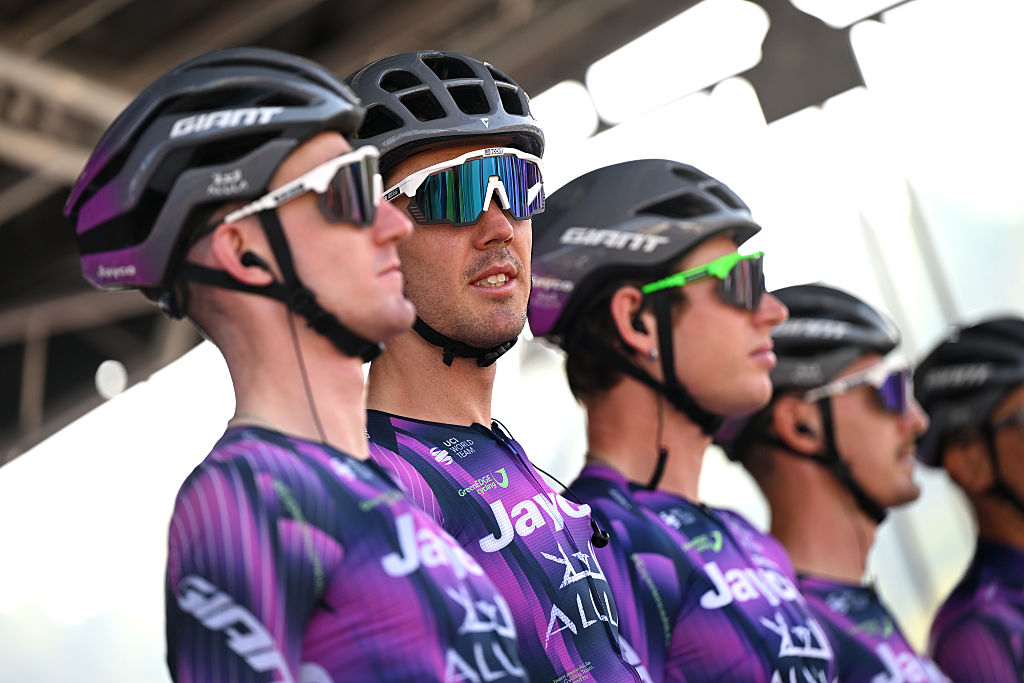Vuelta a España 2024 stage 20 preview - Race tackles toughest mountain stage on final weekend
Picón Blanco summit finish rounds off day of full-on climbing in northern Spain

When the Vuelta a España peloton slowly grinds its way up the final climbing challenge of the 2024 race to the summit finish at Picón Blanco this Saturday, spare a thought for Rein Taaramae (Intermarché-Wanty).
The winner on the same summit back in the 2021 Vuelta, the Estonian veteran had hoped to round out his soon-to-end career in the WorldTour (though he will continue racing in Japan in 2025) by ascending Picón Blanco one last time. But instead of reliving his greatest ever win, not to mention becoming Estonia’s first and to date only leader of the Vuelta, just two days ago Taaramae became too ill to continue the race.
So Taaramae will not, sadly, be part of the peloton when it hits the lower slopes of Picón Blanco in the backstreets of the small town of Espinosa de los Monteros on Saturday afternoon. However, as he told Cyclingnews the morning before he abandoned, in any case, the Vuelta’s 2021 assault on Picón Blanco bears no similarity to how the race will tackle the same daunting cat.1 ascent in 2024.
“Last time the climb was almost at the start of the Vuelta, now it’s right at the end,” he pointed out. “Last time there was only one mountain in the whole stage, but this time there are mountains all day. So it’s going to be totally different. But Picón Blanco stays in my heart in any case, it’s a climb I will never forget.”
Rather than being the first of the Vuelta’s nine summit finishes in 2021, then, in 2024 Picón Blanco is the last of the same total for this year’s race, and it is by far the most decisive. That’s not just because of Picón Blanco’s position in the Vuelta route, either, barely 24 hours before the grand finale. It’s also because of the entire jaw-dropping difficulty of stage 20, by some margin the toughest of an already incredibly tough race.
For one thing, the nearly 5,000 metres of vertical climbing of stage 20 are worthy of the hardest Tour de France or Giro d’Italia trek through the Alps or Pyrenees. But what makes stage 20 even more daunting is the way it gets steadily more difficult, with three first category ascents and a cat. 2 climb all packed into the last 90 kilometres and ‘only’ two cat. 3s and a cat.2 in the first half.
Add them up and no less than seven classified ascents in total will be tackled by the peloton on Saturday, a stage where race leader Primož Roglič could take another major step towards the Vuelta history books and a fourth, record-equalling, overall victory in Madrid on Sunday evening. Yet, regardless of how Roglič fares on the 172 kilometres of almost non-stop climbing and descending, the stage already starts in a town with its own small niche in Vuelta history: Villarcayo is the birthplace of former Spanish racer Iñigo Cuesta, whose total of 17 starts in his home Grand Tour from 1994 through 2010 remains an all-time record.
The latest race content, interviews, features, reviews and expert buying guides, direct to your inbox!
Yet more of the Vuelta’s past, as it happens, will be revisited as soon as the stage hits the second, much more difficult, half on stage 20, on the cat.2 Portillo de la Sia (km 111).
Regularly crossed by the Vuelta as a gateway from central Castilla y León to the more northern region of Cantabria, the Portillo de la Sia is one of the rare climbs tackled in the first ever edition of the Vuelta, way back in 1935, that is still in use today.
Quite apart from its historical importance, the seemingly interminable descent that follows the Portillo de la Sia, dropping from 1,200 metres above sea level to just 200, will likely test the peloton’s concentration to the limit - and perhaps see some downhill ambushes as well.
Then as soon as the peloton reaches the foot of the Sia after nearly 30 kilometres of descending, they immediately hit the cat.1 Puerto de los Tomos. While quite long by Vuelta standards at 11.3km it is not excessively difficult, its gradients being mostly hovering around the 7 to 8% to just one ramp of 10%. But like the Portillo de la Sia, it’s what follows that matters more - just a very short downhill and stretch of flat rather than a full-on descent, which will make it harder to recover prior to the final challenge of the day: Picón Blanco.
Only used once in the Vuelta a España when Taaramae won, but a regular feature of the Vuelta a Burgos (a certain Primoz Roglič took a stage there after crossing its summit in 2022 ahead of Red Bull teammate Aleksandr Vlasov and UAE’s Adam Yates) Picón Blanco is by far the hardest single ascent of stage 20. And as Roglič himself observed after winning on Friday on the Moncalvillo, after three weeks of tough racing, every climb on Saturday will feel twice as difficult as in reality.
Whether still complete after so much climbing or in pieces, all of the Vuelta a España peloton will obligatorily pass through the town of Espinosa de los Monteros at the foot of the Picón Blanco, with the first, easiest part of the ascent in its outlying streets.
“Normally you’d have to worry about being the right position because it’d be a big bunch at the start of the mountain,” Taaramae tells Cyclingnews. “But this time, with so much climbing beforehand, it’s not such a problem. If it was a quiet stage, there will be 50 riders maximum, but I think on Saturday probably 25. So it’ll be more about the legs.”
Almost as soon as it leaves the town, Picón Blanco narrows between drystone walls, steepening notably as it does so and for good measure switching from a smoother surface to a more gravelly, puncture-inducing variety of tarmac.
Very exposed early on, the mountain road subsequently passes through a mixture of scrubby pinewoods and then rough moorland again, before hitting the first of its steepest mid-climb segments, a pitch of 18 per cent, roughly half way up.
Once the climb finally leaves the woodland behind, with around four kilometres to go, though, there are far fewer changes of gradient, just a long, almost completely straight uphill drag at around 10 or 11 per cent reaching up towards the finish, where the big attacks will surely come.
Battered by a ferocious headwind in 2021, Taaramae recalls “It was windy and open at the last part, specially. So if it’s the same this time, then some advice for the leaders - the steep part is just in the middle and that’s where you have to attack because the wind is not so important there.”
“That’s where I opened the gap on the breakaway when I won and then when everybody is on their own afterwards, everybody is in the wind. So there, in the middle of the climb, is maybe where something will happen.”
A series of wind turbines just beyond the summit are a stark reminder of how bleak and exposed the last part of Picón Blanco really is. In 2020, in fact, some dramatic Youtube footage emerged of the weather at the Vuelta a Burgos of riders having to dismount post-stage and walk downhill to the team buses in the teeth of a ferocious gale.
On the way up on Saturday, regardless of which way or how strong the wind blows, the final kilometre with its two near-hairpin bends in quick succession will prove slightly smoother going. But after six kilometres of almost unrelenting steepness, this last series of ramps could see numerous riders in trouble, too.
At this stage in the game, with everybody weary and waiting for the race to end, it’s hard to predict who will succeed Taaramae as the wearer of the red jersey on Picón Blanco - a lead which he held for two days before a mass crash on the flatlands of Albacete forced him to surrender his top spot overall. (Given nobody from his country had ever held the Vuelta lead, one of them, he says, is now in pride of place in a sports museum in Estonia.)
However, as the last ascent of the 2024 Vuelta a España, and the final opportunity for the climbers to shine, the sparks will surely fly -and whoever is in the red will almost certainly be in the same colour 24 hours later on the race’s final podium in Madrid. For them, too, Picón Blanco will likely prove just as unforgettable as it still is for Rein Taaramae.
Get unlimited access to all of our coverage of the 2024 Vuelta a España - including breaking news and analysis reported by our journalists on the ground from every stage as it happens and more. Find out more.
Alasdair Fotheringham has been reporting on cycling since 1991. He has covered every Tour de France since 1992 bar one, as well as numerous other bike races of all shapes and sizes, ranging from the Olympic Games in 2008 to the now sadly defunct Subida a Urkiola hill climb in Spain. As well as working for Cyclingnews, he has also written for The Independent, The Guardian, ProCycling, The Express and Reuters.
Latest on Cyclingnews
-
'We're going to strategically look at the races where we can pick up points' - Jayco-AlUla target UCI ranking in 2026 to avoid relegation pressures
'It is complicated, but that's the modern WorldTour' - New Sporting Manager Gene Bates tells Cyclingnews -
'Nothing motivates people to try a new sport like the Olympic Games' - Cyclocross plays a role equation for US success at elite level
USA Cycling's Brendan Quirk explains four-year plan to 2028 LA Olympics and thinks a cycling discipline in Winter Games would be 'off the charts' in Salt Lake City -
Black Friday Amazon deals 2025: Savings for cyclists at the world's biggest retailer
Everything from bottles to bike lights, Garmin tech to nano-tech bike wash and a whole host more for bike riders in the Amazon Black Friday early sale -
Black Friday bike deals: The biggest discounts for cyclists in the run-up to Black Friday weekend
Our handpicked roundup of the best Black Friday bike deals, with savings of up to 55% on Assos, Garmin, Castelli, Specialized and more




